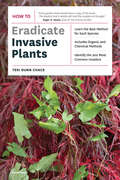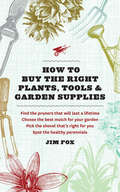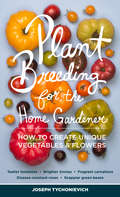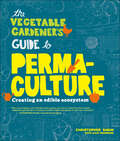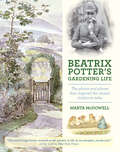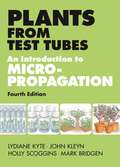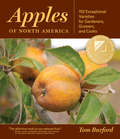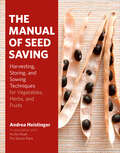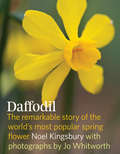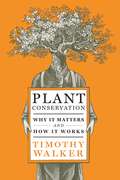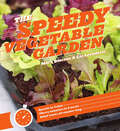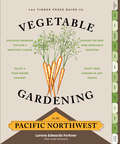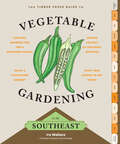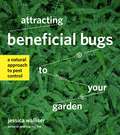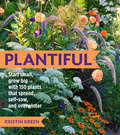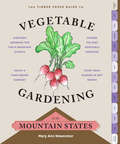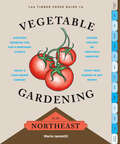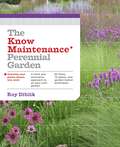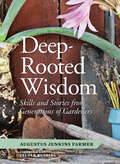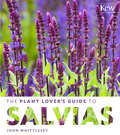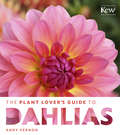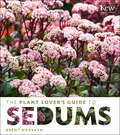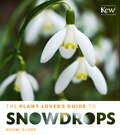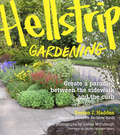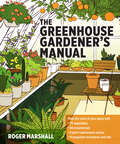- Table View
- List View
How to Eradicate Invasive Plants
by Teri Dunn Chace“Every garden shed should have a copy of this book. The wisdom that it wields will hold the invaders at the gate.” —Roger B. Swain, The Victory GardenHow to Eradicate Invasive Plants offers a clear, practical solution to the increasingly common problem of invasive plants. Clearly written and easy-to-use, Teri Dunn Chance shows you how to recognize more than 200 common invasive plants and offers organic and responsible chemical eradication options for each species. With this reference on their shelves, gardeners, landscapers, and managers of public and private land across the country can confidently tackle the invasive plants to make room for a sustainable plant community!
How to Buy the Right Plants, Tools, and Garden Supplies: Find The Pruners That Will Last A Lifetime Choose The Best Mulch For Your Garden Pick The Shovel That's Right For You Spot The Healthy Perennials
by Jim FoxAre you confused by all the choices when you visit a nursery? Do you get sticker shock when you see how much that nice little shade tree costs? Let Jim Fox, a nursery professional with over twenty years of experience, show you how to become a savvy garden consumer and get the most for your hard-earned landscaping dollars. <P><P>How to Buy the Right Plants, Tools, and Garden Supplies will arm you with a wealth of knowledge! You’ll learn how to determine if a plant is healthy, how to choose the right size, how to correctly read the plant tag, how to choose the best tools and supplies for your needs, and how to confidently recognize a well-made tool. <P><P> In addition to helping you navigate the nursery, it tells you what you need to know before you get there and offers helpful tips on how to successfully garden once you get home.With this essential guide in hand, you’ll never experience buyer’s remorse again!
Plant Breeding for the Home Gardener: How to Create Unique Vegetables and Flowers
by Joseph TychonievichBrighter zinnias, fragrant carnations, snappier green beansPlant Breeding for the Home Gardener makes it easier than ever to breed and grow your own varieties of vegetables and flowers. This comprehensive and accessible guide explains how to decide what to breed, provides simple explanations on how to cross plants, and features a basic primer on genetics and advanced techniques. Case studies provide breeding examples for favorite plants like daffodils, hollyhocks, roses, sweet corn, and tomatoes.
The Vegetable Gardener's Guide to Permaculture: Creating an Edible Ecosystem
by Julie Thompson Christopher Shein“A masterful distillation of permaculture in a way that is easy to apply to our gardens, farms, and lives today.” —David Cody, founder, Urban Permaculture Institute Once a fringe topic, permaculture is moving to the mainstream as gardeners who are ready to take their organic gardening to the next level are discovering the wisdom of a simple system that emphasizes the idea that by taking care of the earth, the earth takes care of you.The Vegetable Gardener's Guide to Permaculture teaches gardeners of every skill—with any size space—how to live in harmony with both nature and neighbors to produce and share an abundant food supply with minimal effort. Permaculture teacher Christopher Shein highlights everything you need to know to start living off the land lightly, including how to create rich, healthy, and low-cost soil, blend a functional food garden and decorative landscape, share the bounty with others, and much more.
Beatrix Potter's Gardening Life: The Plants and Places That Inspired the Classic Children's Tales
by Marta McDowell“An enchanting and original account of Beatrix Potter's life and her love of plants and gardening.” —Judy Taylor, vice president of the Beatrix Potter Society There aren’t many books more beloved than The Tale of Peter Rabbit and even fewer authors as iconic as Beatrix Potter. More than 150 million copies of her books have sold worldwide and interest in her work and life remains high. And her characters—Peter Rabbit, Jemima Puddle Duck, and all the rest—exist in a charmed world filled with flowers and gardens. Beatrix Potter’s Gardening Life is the first book to explore the origins of Beatrix Potter’s love of gardening and plants and show how this passion came to be reflected in her work. The book begins with a gardener’s biography, highlighting the key moments and places throughout her life that helped define her, including her home Hill Top Farm in England's Lake District. Next, the reader follows Beatrix Potter through a year in her garden, with a season-by-season overview of what is blooming that truly brings her gardens alive. The book culminates in a traveler’s guide, with information on how and where to visit Potter’s gardens today.
Plants from Test Tubes: An Introduction to Micropropogation, 4th Edition
by Holly Scoggins Mark BridgenThirty years ago, in vitro propagation was a new technique for producing plants, and Lydiane Kyte’s Plants from Test Tubes became the standard work on the topic.The new fourth edition has been thoroughly revised and updated to reflect the many advances in science and technology, including the five accepted sequential stages of micropropagation. Ten new plants have been added. This in turn has greatly expanded the already extensive bibliography. Among the new topics that have been introduced or expanded on are embryo culture for breeding, somaclonal variation, anther culture, somatic embryogenesis, cryopreservation, and genetic engineering. More ornamental plant examples are given and many new illustrations provided, including a chronology of discoveries in micropropagation.
Apples of North America: Exceptional Varieties for Gardeners, Growers, and Cooks
by Tom BurfordAmerican Horticulture Society Award Winner The apple is one of the most iconic fruits, traditionally picked on cool fall days and used in pies, crisps, and ciders. And there is a vast world of varieties that goes beyond the common grocery store offerings of Red Delicious and Granny Smith. With names like American Beauty, Carter’s Blue, and Fallawater, and flavors ranging from sweet to tart, this treasure trove of unique apples is ripe for discovery. There is no better guide through this tasty world than Tom Burford, whose family has grown apples in the Blue Ridge Mountains since 1715. The book is brimming with beautiful portraits of heirloom and modern apples of merit, each accompanied by distinguishing characteristics and common uses. As the view broadens to the orchard, you will find information on planting, pruning, grafting, and more. The exploration of the apple culminates with an overview of the fruit’s transformative capabilities when pressed, fermented, cooked, or dried. Beyond the polished and predictable grocery store display of Red Delicious and Granny Smith apples, a feast of beautiful and uniquely flavored North American varieties awaits the curious.
The Manual of Seed Saving: Harvesting, Storing, and Sowing Techniques for Vegetables, Herbs, and Fruits
by Ian Miller Andrea Heistinger“Makes it easy to find information in a snap, on most any edible you want to grow.” —Kylee Baumle, Horticulture Growing vegetables, fruits, and herbs from seed has many benefits for both the gardener and the planet. Why save seeds when you can buy them so cheap? Not only does seed saving allow you to grow a diverse, organic array of fruits and vegetables, it also offers an opportunity to work closely with nature and be even more hands-on with the food you grow, cook, and eat. Supported by research from the global conservation organizations Arche Noah and Pro Specie Rara, The Manual of Seed Saving features information on how to maximize seed quality and yield for crop plants like asparagus, carrots, corn, rhubarb, spinach, squash, and tomatoes. Plant profiles include critical information on pollination, isolation distances, cultivation, harvest, storage, and pests and diseases.
Daffodil: The remarkable story of the world's most popular spring flower
by Noel Kingsbury Jo WhitworthThere is no harbinger of spring like a field or garden filled with bright yellow daffodils. But the world of the daffodil is much more than just its place in the march of the seasons. It’s a plant whose history starts with the tombs of the Pharaohs, through pre-Darwin evolutionary theory and Cornwall’s burgeoning bulb business, and leads to the current explosion of varieties from plant breeders seeking new colors, fragrances, and forms.Daffodil reveals a global plant infatuation that has led to more than 25,000 cultivars available in nearly every shade of yellow (and now pink, orange, and white). Noel Kingsbury tells the tale through an engaging narrative history and plant portraits that highlight more than 200 varieties. Jo Whitworth's revealing photography shows a side of the daffodil rarely seen. Plant lovers will relish the stories and gardeners will cherish the cultivation notes, plant descriptions, and recommendations.
Plant Conservation: Why It Matters and How It Works
by Timothy WalkerPlants’ ability to turn sunlight into energy makes them the basis for all life; without them there is no life. And they are more than just a food source—they provide us with fuel, fibers, and pharmaceuticals. Global warming and the destruction of natural habitats are a serious threat to many plants, and there are worldwide efforts to mitigate the disaster. Plant Conservation tackles this essential topic head on. Timothy Walker, as the director of the Oxford Botanical Garden, a leader in the field of plant conservation, plays a key role in this effort. He highlights what is happening now, from cataloging the world’s flora to conservation efforts like protecting plants from overcollecting. He also shows home gardeners how they can become involved, whether by growing their own food to decrease reliance on large agriculture or by making smart plant choices by growing natives and avoiding invasives. Plant Conservation treats a critical topic in an accessible and optimistic way. It is required reading for students, professionals, and anyone with a keen interest in the importance of plants.
The Speedy Vegetable Garden
by Mark Diacono Lia LeendertzTypically, vegetable gardening is about the long view: peas sown in spring aren't harvested until summer, and tomatoes started indoors in February can't be eaten until July. But it's not true for all plants. Some things can be planted and eaten in weeks, days, even hours.The Speedy Vegetable Garden highlights more than 50 quick crops, with complete information on how to sow, grow, and harvest each plant, and sumptuous photography that provides inspiration and a visual guide for when to harvest. In addition to instructions for growing, it also provides recipes that highlight each crop’s unique flavor, like Chickpea sprout hummus, stuffed tempura zucchini flowers, and a paella featuring calendula. Sprouted seeds are the fastest. Microgreens can be harvested in weeks: cilantro, 14 days after planting; arugula and fennel in 10 days. And a handful of vegetable varieties grow more quickly than their slower relatives, like dwarf French beans (60 days), cherry tomatoes (65 days), and early potatoes (75 days).The Speedy Vegetable Garden puts fresh, seed-to-table food at your fingertips, fast!
The Timber Press Guide to Vegetable Gardening in the Pacific Northwest: A Timber Press Guide (Regional Vegetable Gardening Series)
by Lorene Edwards ForknerThere is nothing more regionally specific than vegetable gardening. What to plant, when to plant it, and when to harvest are unique decisions based on climate, weather, and first and last frost.The Timber Press Guide to Vegetable Gardening: Pacific Northwest is a growing guide that truly understands the unique eccentricities of the Northwest growing calendar, covering Oregon, Washington, southeastern Alaska, and British Columbia. The month-by-month format makes it perfect for beginners and accessible to everyone—you can start gardening the month you pick it up. Starting in January? The guide will show you how to make a seed order, plan crop rotations and succession plantings, and plant a crop of microgreens. No time to start until July? You can start planting beets, carrots, chard, kale, parsnips, and spinach for an early fall harvest.
The Timber Press Guide to Vegetable Gardening in the Southeast (Regional Vegetable Gardening Series)
by Ira WallaceGrowing vegetables requires regionally specific information—what to plant, when to plant it, and when to harvest are based on climate, weather, and first frost. The Timber Press Guide to Vegetable Gardening in the Southeast tackles this need head on, with regionally specific growing information written by local gardening expert, Ira Wallace. This region includes Alabama, Arkansas, Florida, Georgia, Kentucky, Louisiana, Maryland, Mississippi, North Carolina, South Carolina, Tennessee, Virginia, and West Virginia. Monthly planting guides show exactly what you can do in the garden from January through December. The skill sets go beyond the basics with tutorials on seed saving, worm bins, and more.
Attracting Beneficial Bugs to Your Garden: A Natural Approach to Pest Control
by Jessica WalliserWinner of the American Horticultural Society Book Award Insects are indeed valuable garden companions, especially the assassin bugs, damsel bugs, stink bugs, and other predatory carnivores that eat the insects that dine on your garden. Attracting Beneficial Bugs to Your Garden is a book about bugs and plants, and how to create a garden that benefits from both. In addition to information on companion planting and commercial options for purchasing bugs, there are 19 detailed bug profiles and 39 plant profiles. These profiles include a description, a photograph for identification, an explanation of what they can do to support pest control. Design plans show how to create a border specifically for the natural, sustainable inclusion of beneficial bugs in your garden.
Plantiful: Start Small, Grow Big with 150 Plants That Spread, Self-Sow, and Overwinter
by Kristin Green“Thrifty gardeners take note: the bucks saved on plant purchases will pay back the purchase price of Plantiful with dividends.” —Tovah Martin, author of The Unexpected Houseplant Whoever coined the phrase “money doesn’t grow on trees” must not have been a resourceful gardener. Plantiful shows you how to have an easy, gorgeous garden packed with plants by simply making the right choices. Kristen Green highlights plants that help a garden quickly grow by self-sowing and spreading and teaches you how to expand the garden and extend the life of a plant by overwintering. The book features plant profiles for 50 self-sowers (including columbine, milkweed, and foxglove), 50 spreaders (such as clematis, snow poppy, and spearmint), and 50 plants that overwinter (including lemon verbena, begonia, and Chinese hibiscus). Additional gardening tips, design ideas, and inspirational photos will motivate and inspire gardeners of all levels.
The Timber Press Guide to Vegetable Gardening in the Mountain States (Regional Vegetable Gardening Series)
by Mary Ann NewcomerGrowing vegetables requires regionally specific information—what to plant, when to plant it, and when to harvest are based on climate, weather, and first frost. The Timber Press Guide to Vegetable Gardening in the Mountain States tackles this need head on, with regionally specific growing information written by local gardening expert, Mary Ann Newcomer. This region includes Idaho, Montana, Wyoming, Utah, Colorado, eastern Washington and Oregon, northern Nevada, and the southernmost parts of Alberta and Saskatchewan. Monthly planting guides show exactly what you can do in the garden from January through December. The skill sets go beyond the basics with tutorials on seed saving, worm bins, and more.
The Timber Press Guide to Vegetable Gardening in the Northeast (Regional Vegetable Gardening Series)
by Marie IannottiGrowing vegetables requires regionally specific information—what to plant, when to plant it, and when to harvest are based on climate, weather, and first frost. The Timber Press Guide to Vegetable Gardening in the Northeast tackles this need head on, with regionally specific growing information written by local gardening expert, Marie Iannotti. This region includes Connecticut, Delaware, Maine, Massachusetts, New Hampshire, New Jersey, New York, Pennsylvania, Rhode Island, and Vermont. The southernmost parts of Ontario, New Brunswick, Novia Scotia, and Quebec are also included. Monthly planting guides show exactly what you can do in the garden from January through December. The skill sets go beyond the basics with tutorials on seed saving, worm bins, and more.
The Know Maintenance Perennial Garden
by Roy Diblik“A veritable goldmine for gardeners.” —Plant Talk We’ve all seen gorgeous perennial gardens packed with color, texture, and multi-season interest. Designed by a professional and maintained by a crew, they are aspirational bits of beauty too difficult to attempt at home. Or are they?The Know Maintenance Perennial Garden makes a design-magazine-worthy garden achievable at home. The new, simplified approach is made up of hardy, beautiful plants grown on a 10x14 foot grid. Each of the 62 garden plans combines complementary plants that thrive together and grow as a community. They are designed to make maintenance a snap. The garden plans can be followed explicitly or adjusted to meet individual needs, unlocking rich perennial landscape designs for individualization and creativity.
Deep-Rooted Wisdom: Skills and Stories from Generations of Gardeners
by Augustus Jenkins FarmerWe have begun to lose some of the most important skills used by everyday gardeners to create beautiful, productive gardens. With a personality-driven, engaging narrative, Deep Rooted Wisdom teaches accessible, commonsense skills to a new generation of gardeners. Soulful gardener, Augustus Jenkins Farmer, profiles experienced and up-and-coming gardeners who use these skills in their own gardens. Enjoy this chance to get planting, propagation, and fertilizing knowledge handed down directly from the experts in the field.
The Plant Lover's Guide to Salvias (The Plant Lover’s Guides)
by John WhittleseySalvias are available in a huge range of sizes, colors, foliage, and hardiness, with over 900 species and hundreds of hybrids. Salvia’s popularity stems from how easy they are to grow, their multiple medicinal and culinary uses, and the vibrancy of their blooms that cover every color in the spectrum from white to nearly black. The Plant Lover’s Guide to Salvias features everything you need to know to grow this vibrant and fragrant plant. Plant profiles of 150 varieties highlight each plant’s type, habitat, size, hardiness, origin, cultivation, and use in the landscape. Additional information includes tips on design, how to grow and propagate salvia, where to view them in public gardens, and where to buy them.
The Plant Lover's Guide to Dahlias (The Plant Lover’s Guides)
by Andy VernonDahlias are the showgirls of the garden. A favorite of floral and landscape designers, they come in a wide range of jewel-like colors—rich reds and vibrant oranges, shocking pinks—and an engaging variation of form and petal shape. The Plant Lover’s Guide to Dahlias is packed with everything you need to know to grow these fantastic flowers including tips on using dahlias in garden design, growth and propagation information, and lists of where to buy the plants and where to view them in public gardens. The bulk of the book is devoted to profiles for over 200 varieties, organized by color, with information on type, height, and spread. Gorgeous color photographs bring the plants to life.
The Plant Lover's Guide to Sedums (The Plant Lover’s Guides)
by Brent HorvathSedums are most popular flowering succulent. They range from groundcovers to large border perennials and are often included in green roof and vertical garden design because of their visual interest and drought tolerance. Sedums changes dramatically with the seasons—in fall, they are rich and earthy while in summer their flowers come in vibrant shades of pink and yellow. The Plant Lover’s Guide to Sedums includes everything you need to know about these beautiful gems. Plant profiles highlight 150 of the best varieties to grow, with information on zones, plant size, soil and light needs, origin, and how they are used in the landscape. Additional information includes designing with sedums, understanding sedums, growing and propagating, where to buy them, and where to see them in public gardens.
The Plant Lover's Guide to Snowdrops (The Plant Lover’s Guides)
by Naomi SladeSnowdrops have a delicate, quiet beauty. Their white bell-shaped petals are striking alone and in a swath, and they are a harbinger of spring. The Plant Lover’s Guide to Snowdrops is the first book to make this group of bulbs accessible to the home gardener. It features profiles of 60 hybrids, species, and cultivars, with information on flowering time, distinguishing features, and ease of cultivation. It addition, it shows how to design with snowdrops, and how to grow and propagate them, also offering tips on where to see snowdrops in public gardens and where to buy them. Each Plant Lover’s Guide in the series is supported by lush, photo-driven design, featuring the most beloved plants and valued expertise of the gardening world in a visual, comprehensive resource.
Hellstrip Gardening: Create a Paradise between the Sidewalk and the Curb
by Evelyn Hadden Joshua McCulloughThe hellstrip—also known as a boulevard, meridian, and planting strip—is finally getting the attention it deserves! Gardeners everywhere are taking advantage of the space to add curb appeal to their homes, expand the size of their gardens, and conserve more resources. Hellstrip Gardening is the first book to show you exactly how to reclaim these oft-ignored spaces by determining the city and home owner's association rules, choosing plants that thrive in tough situations, designing pathways for accessibility, and much more. Gorgeous color photographs of hellstrip gardens across the country offer inspiration and visual guidance to anyone ready to tackle this final frontier.
The Greenhouse Gardener's Manual
by Roger MarshallImagine biting into a fresh, juicy tomato straight from the vine in the middle of winter or growing a collection of succulents and cacti the coldest parts of the world. In The Greenhouse Gardener's Manual, Roger Marshall providesevery tool and technique you need to successfully grow edibles and ornamentals in a well-maintained greenhouse. Marshall offers insight to choose the right greenhouse, create a healthy environment, start seeds and propagate, and maintain your greenhouse.
